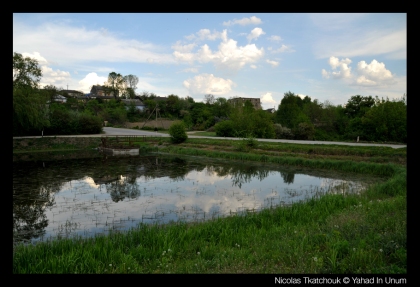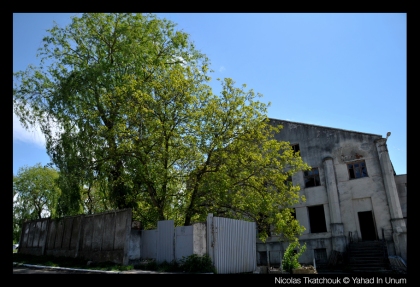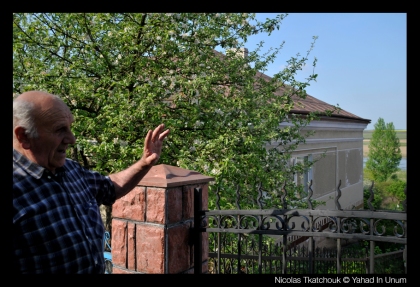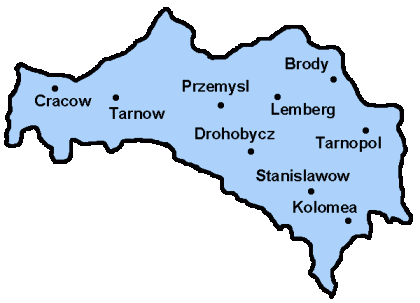Filed under: Field Report | Tags: Civilians, Eastern Europe, Grimalov, Local Cooperation, Local Involvement, Mass Murder, Nazis, Pogram, Ritual, Ternopil, Wehrmacht, Witnesses
The involvement of local populations in the Nazis’ extermination plan is always a significant question. To what extent did non-Jews resist the removal of Jewish rights, the scheduled deportations, the impromptu massacres? If local populations didn’t resist, were they actively involved? Father Desbois’ expedition to Ternopil brings to light an important instance of local cooperation with the Nazis.
In Ternopil, the Nazis took advantage of that longstanding Eastern European ritual–the pogrom–and organized their own, more deadly pogrom. Father Desbois writes:
“We managed to find witnesses who would agree to speak about pogroms: four people recounted the execution of nearly a third of the Jewish population of the village of Grimaïlov… They were instigated and, in part, led by the newly arrived Wehrmacht… The [Wehrmacht] encouraged the civil Ukrainian population to take part in the shootings..”

Pond in Grimalov, site of the pogrom.

Stanislav refused to participate in the pogrom.
If the Nazis created the most organized machine for mass murder that has ever existed, they also used a more unscripted method that had existed for hundreds of years.
Filed under: Field Report | Tags: Camps, Concentration Camps, Father Desbois, Galicia, Kamianki, Maksymovka, Novosilka, Romanove, Selo, Skalat, Stoupki, Stoupki 2, Ternopil
In the most recent report from our team in the field, Father Desbois makes a groundbreaking discovery.
The massacres of the East have always posed notorious difficulties for researchers because of the lack of physical evidence available. Unlike in the West, where the Holocaust was carried out by a highly organized and visible infrastructure of concentration camps, railroads, and factories, there was thought to be no permanent structures in the East that would testify to the deaths of 1.5 million Jews.
But Father Desbois has found eight camps in Ternopil that were necessary for the Nazis to build in order to handle the region’s large Jewish population.
One of the buildings in the village camp at Skalat:

The Discovery of the Camps
“[We are conducting our] investigations in the Ternopil region,” writes Father Desbois. “This visit is mainly focused on searching for camps designed for the very large Jewish population in the region. After a little less than ten days, we investigated eight camps (Maksymovka, Romanove, Selo, Kamianki, Stoupki, Stoupki 2, Skalat, Novosilka), not one of which was mentioned in the German or Soviet archives, and we questioned more than thirty people who were witnesses to them.”
How the Camps Were Run
“… It seems certain to us that these camps are based around the railroad line and the route connecting Temopil to Vinnitsia, essential to the German war effort. They are distinguishable by several recurring and characteristic aspects: the Jewish prisoners of the camp were systematically exterminated inside the camps. The majority of the detainees are men, Jewish women being kept in particular buildings and having to look after the affairs of prisoners and guards. In many cases, the camp is placed under the guard of Jewish police.”
In the village of Veliki Gloubotchek, Emelian shows the private garden in which there rest today more than 300 Jews who were detained in the camp of the village, shot, and then burned.

Involvement of the Local Population
“The bodies of victims buried in pits almost always underwent exhumation and cremation organized by the Nazi authorities (Operation 1005). Ultimately, our investigation brought to light the complete lack of efforts to hold executions and cremation of the secret corpses: we found two of the many villagers in the Kamianki camp, one ordered to carry the wood necessary to burn the bodies, the other to take out the bodies with a farm hook. In the village of Veliki Gloubotchek, the villagers were ordered to gather the bodies of escaped Jews, shot on the way to execution, and to pile the cadavers with wood in preparation for the cremation of the bodies…”
Father Desbois’ discovery of the camps in Ternopil is groundbreaking: he is providing the first-ever instance of documentation of the camps of Ternopil.
Filed under: Historical Background | Tags: Austro-Hungarian Empire, Concentration Camps, Eastern Europe, Father Desbois, Galicia, History, Jewish Population, Jewish Records Indexing Project, Poland, Polish Partitions, Ternopil, Ukraine, World War II
Father Desbois is currently recording testimony in the Ternopil region of the Ukraine. But where is Ternopil and how is it connected with the rest of Eastern Europe?
Ternopil is part of a region of Eastern Europe known as Galicia, a province that stretched across what is now Poland and the Ukraine. It is a region with a rich and complex history, and it once held a large Jewish population, among dozens of other ethnic groups and cultures. Ternopil sits on the eastern end of Galicia.
The region retained its complex diversity until World War II, when Galicia’s population was relocated, and its Jews sent to concentration camps or massacred near the villages they lived in. Father Desbois is now investigating the last remnants of the ancient Jewish communities of Ternopil.
Galicia was originally formed as a province of the Austrian empire (which later became the Austrian-Hungarian Empire), through the Polish Partitions. The Austrian-Hungarian was dissolved at the end of World War I, and Galicia consequently became part of Poland; in 1939, it became part of the Soviet Union. It is now split between the Ukraine and Poland.

Map of Galicia During the Austro-Hungarian Empire
Undoubtedly, some of our readers have ancestors who came from this region; if someone Jewish in your family came from from Poland, there’s a good chance they emigrated from Galicia. You can conduct your own research through the Jewish Records Indexing Project.
You can also search through the Vital Records for Galician Towns to find the location of records that pertain to each town in Galicia during the Austro-Hungarian Empire.
For more historical background on Jewish life in Galicia, you can read Piotr Wrobel’s article The Jews of Galicia under Austrian-Polish Rule, 1867-1918.